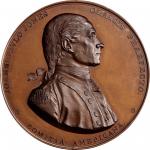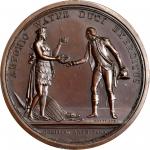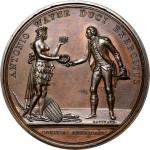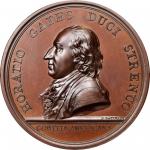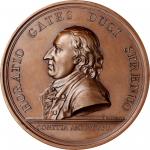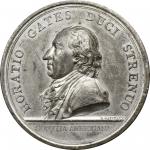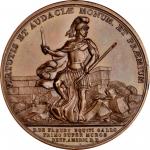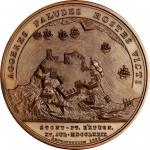1779 (i.e. after 1880) De Fleury at Stony Point medal. As Betts-566, Julian MI-4. Copper. U.S. Mint copy dies. Philadelphia Mint. 46.0 mm, 849.6 grains. 4.3 - 4.4 mm thick. Mint State.Plain square edge. Lustrous and lightly reflective, with light brown surfaces highlighted with rose and gold. Double struck to bring up the exacting relief, with some doubling seen among the reverse legends. Very attractive, though a few trivial marks are noted, including a couple on the raised rim above MI of PRAEMIUM. A spot of corrosion is hidden on the edge below 3:00, relative to the obverse, but invisible from either side. One of the most elusive Philadelphia Mint medals of the Comitia Americana series, with a mintage of just 45 between 1882 and 1904. The copy dies were prepared in 1880 but not put into use until the second half of 1882; the initial mintage of 20 must have sold out quickly, as two more medals were struck the following year.<p>According to Julian, Mint Superintendent A. Loudon Snowden borrowed a silver original De Fleury medal from a New York collector named Robert Stuart in March 1880. After new dies were produced, copying their central motifs from Stuarts medal but composed with new punches and lettering, "Snowden returned the silver medal along with a newly-struck bronze copy on June 24, 1880." Interestingly, no bronze medal was listed on the 1880 roster of medals manufactured at the Philadelphia Mint, suggesting that those mintage figures can perhaps be taken with a grain of salt. Regardless of the precise figure, this is a very scarce U.S. Mint medal, one that challenges even those collectors who have decided to forego acquisition of a Paris original.<p><strong>The Battle of Stony Point</strong><p><strong>The Action: </strong><p><p>One need not be a military mastermind to look at a map and understand the strategic importance of the Hudson River. From New York Citys seaward port to the Canadian border, the Hudson River acts as a wet superhighway, navigable for all but a 12 mile overland portage from the falls of the Hudson to the southern tip of Lake George, whose northern end connects to Lake Champlain at Fort Ticonderoga. Control of this waterway could effectively cleave New England from the mid Atlantic states and thus manage the entire Northern theatre of the American Revolution.<p>When two minor forts along the Hudson fell into British hands in May 1779, Washington was alarmed. Sir Henry Clintons forces captured Verplancks Point and Stony Point, across the river from each other at a narrow choke point 12 miles downriver from West Point. The forts themselves werent of great importance, but they represented the termini of Kings Ferry, the main commercial path across the Hudson in the region. With West Point fortified to command the river, and Washingtons main army in the area, it was important to retake what was lost.<p>Washington worked quickly, asking Pennsylvania Line commander Gen. Anthony Wayne to lead an expedition against Stony Point, on the west side of the river. The British position was atop a hilly peninsula that was accessible only from the low swampland to the west. Wayne built a small force of infantry and engineers to retake Stony Point. The 1,150 men of the Light Infantry gathered in the middle of the night under a veil of darkness and silence; Wayne is said to have had dogs in the neighborhood killed so none would sound an alarm. Muskets were unloaded and bayonets were fixed, giving Wayne not only the advantage of a quiet approach, but also a chance to avenge the bayonet massacre near his Pennsylvania home that became known as the Battle of Paoli. "Remember Paoli" became one of the rallying cries of his force as they put their bayonets to use at Stony Point.<p>Wayne commanded the full body of troops, while the right and left advance guards were commanded by the patrician French engineer Lt. Col. Francois De Fleury and Major John Stewart, respectively. De Fleury was the first to breach the forts earthworks and grab the British flag, yelling "The forts our own!" When Wayne wrote to Washington at daybreak to report the victory, he told the general "our officers and men behaved like men who are determined to be free." <p>Wayne and his men had captured valuable supplies, more than 500 British soldiers, and 15 artillery pieces in 25 minutes of brisk action, losing just 15 killed. This was not a major battle, nor was it a major victory, but its success nonetheless delighted Washington and the members of the Continental Congress, none of whom had gotten much good news during the 1779 campaign season. Wayne, De Fleury, and Stewart were all voted medals just days after the taking of Stony Point.<p><strong>The Resolution:</strong><p><em>Resolved, unanimously, That Congress entertain a proper sense of the good conduct of the officers and soldiers under the command of Brigadier General Wayne, in the assault of the enemys works at Stoney Point, and highly commend the coolness, discipline and firm intrepidity exhibited on that occasion.</em><p><em>Resolved, unanimously, That Lieutenant Colonel Fleury, and Major Stewart, who, by their situation in leading the two attacks, had a more immediate opportunity of distinguishing themselves, have, by their personal achievements, exhibited a bright example to their brother soldiers, and merit in a particular manner the approbation and acknowledgment of the United States.</em><p><em>Resolved, unanimously, That Congress warmly approve and applaud the cool, determined spirit with which Lieutenant Gibbons and Lieutenant Knox led on the forlorn hope, braving danger and death in the cause of their country.</em><p><em>Resolved, unanimously, That a medal, emblematical of this action, be struck:</em><p><em>That one of gold be presented to Brigadier General Wayne, and a silver one to Lieutenant Colonel Fleury and Major Stewart respectively and that five thousand of copper be struck for Congress.</em><p><em>- Continental Congress Resolution of July 26, 1779</em><p><strong>De Fleury at Stony Point</strong><p><strong>The Acquisition: </strong><p>The only foreign officer to receive a medal for heroism during the American Revolution was also the first to receive his finished prize. Robert Troup, the secretary of the Continental Congress Board of Treasury, wrote to Benjamin Franklin in Paris in September 1779 to ask him to begin work on several medals: "The impracticability of executing the Work in this part of the World obliges the Board to forward them to you with an earnest request to have the Medals voted struck as soon as possible with such Devices as may be judged emblematical of the Occasions which excited the Notice and obtained the Thanks of Congress." Troup also requested that the dies be forwarded to America as soon as possible.<p>Within just a few months, Lt. Col. De Fleury was already writing to Benjamin Franklin dictating the inscriptions for his silver medal and requesting that a specimen be delivered to King Louis XVI.<p><em>Sir</em><p><em>The king has dezired me to send to him my medaille; I did answer, you had Received order to have it struck; & that as soon it would be done, I should present it to him. </em><p><em>If it was possible it Could be struck next week, I would be much obliged to you. Or if you have too much business, give me that Care; tell me the price you intend to put to it, & I shall Carrefully follow your directions.</em><p><em>I Could wish in one side the fort of Stonypoint, with this motto. aggeres, paludes, hostes victi. On the other side. A crown of Laurels, with a flag Struck. & this motto- Corona muralis. Round it, the united States to L. C. Fleury.</em><p><em>I beg you would answer to Me as soon as possible, & believe me very Respectfully your Most obedient humble servant</em><p><em>Fleury</em><p>Franklin, ever eager to please the French, set to work at a pace that was unusual for him. He wrote De Fleury in January 1780 to ask for help locating a proper medalist. There is no record De Fleury was helpful in that regard, but in March 1780 the well-born officer wrote to Franklin to inform him that he would be rejoining his regiment but that his medal could be left with his father. De Fleury also asked if a gold medal could be struck at his own expense. "It will not hurt the dies," De Fleury wrote, "I leave the money for that purpose in the hands of the medalist. He will keep the gold medal for me till my return."<p>While Franklin had De Fleurys medal struck with some of the inscriptions he had requested - Aggeres Paludes Hostes Vici does indeed appear on the reverse of his medal around an image of the fort at Stony Point - he does not appear to have satisfied De Fleurys ego by allowing a medal to be struck in gold, a composition intended exclusively for those of a generals rank and not their junior officers, no matter how wealthy or influential.<p>Pierre-Simon Duvivier wrote to Franklin on April 20, 1780, to report that De Fleurys medal had been completed, but also asked Franklin to come look at the proofs of the unhardened dies "to take advantage of your opinions while there is still time: "je desirerois avant de faire tremper les coins avoir lhonneur de vous en montrer les Épreuves pour profiter de vos avis pendant quil en est encore temps."<p>Within a month, the medals had been struck, as Duvivier reported to Franklin in a letter dated May 27, 1780. Franklin wrote home to Samuel Huntington, President of the Continental Congress, on May 31 to pass along the news. "The Medal for M. Fleury is done and deliverd to his Order, he being absent." Duvivier displayed the medal at the Salon of 1781. De Fleury was given the medal upon his return to France in August 1783.<p>The Presentation:<p>On April 15, 1783, Benjamin Franklin sent the medal to De Fleury, along with the following letter, written in French (translated here into English):<p><em>Sir,</em><p><em>I have the honor to send you, in accordance with the orders of the Congress, the Medal which they ordered me to have struck, in memory of your good action at the attack of Fort Stony-Point, to present it to you on their behalf.</em><p><em>I fulfill this duty with pleasure, having myself a high opinion of your merit. I desire you to carry for a long life this honorable mark of their consideration.</em><p><em>I am, with great esteem, &c.</em><p><em>B. Franklin</em><p>Franklins letter was republished in the French press in the autumn of 1783, leading the editors of Franklins papers to wonder if the letter was written by Franklin in 1780 but republished with an edited date by the newspapers of the time. Your cataloger suspects its more likely that the medal was held by Duvivier, retrieved by Franklin in 1783, and presented upon De Fleurys return in that year.<p><strong>The De Fleury at Stony Point Medal:</strong><p><strong>Obverse:</strong> De Fleury, depicted as a Roman centurion, raises a short sword in one hand while upending the British flag with the other, standing triumphant in the rubbled debris of the fort at Stony Point. VIRTUTIS ET AUDACIAE MONUM. ET PRAEMIUM or "A monument and prize for virtue and boldness" surrounds the periphery, while the densely packed exergue reads D DE FLEURY EQUITI GALLO PRIMO SUPER MUROS RESP. AMERIC. D.D. or "to the French officer De Fleury, the first to conquer the walls, given by the American Republic."<p><strong>Reverse: </strong>A fantasy depiction of the fortification atop Stony Points mountainous plateau, with six ships in the Hudson beyond and a positively enormous flag inside the right wall. The legend, as requested by De Fleury himself, reads AGGERES PALUDES HOSTES VICTI or "Fortifications, swamps, and the enemy overcome" with an exergual inscription STONY PT. EXPUG. XV JUL MDCCLXXIX or "Stony Point taken 15 July 1779." The overall design resembles that of the 1758 Oswego Captured and other earlier French military medals.<p><p><p><p>From the John W. Adams Collection. Acquired from Dr. Paul Patterson, June 1986.












